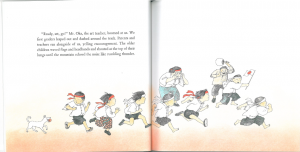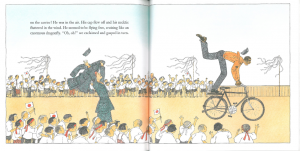
Author/ Illustrator: Allen Say
Publishing Information: Parnassus Press Oakland California, 1982
Number of Pages: 39
Genre: Realistic Fiction, Picture book


Analysis:
On the sports day of a school in the south island of Japan, two American soldiers play a few tricks on a bicycle. Students cheer for them and they have a good time together.
The book is a first-person narrative of the author who went to school in Japan. It is based on historical facts. Just after World War II, Japan was still recovering from the damages from the war. However, this story demonstrates that piece of history from a very different view of point. I can hardly notice that the war just happened by looking at such a peaceful and quiet village. The book functions as a window for children to look at another culture. A lot of cultural elements are presented in the book such as various traditional Asian games and the fact that people bow to greet each other. One of the critiques I have about this book is that, I think the book might convey an idea that only Americans can lighten up the life of Japanese by portraying the American soldier showing off his bicycle skills. American characters exist as rescuers and they are depicted a lot taller.
Perceptually, the author and illustrator uses water colors and ink to draw the illustrations which shows calm and peace. Brighter colors are used to depict the joyful atmosphere. The book does a great job stressing diversity and culture. The author takes good care of diversity issue since the numbers of male and female in the illustrations are about average. Besides, one of the American soldiers is African American. Structurally, most of the text and images do not overlap. Some ideology conveyed in this book is culture based. Asian philosophy stresses on group spirit more than individuality. And the principal emphasizes “the spirit of sportsmanship” which is “Whether we win or lose, let us enjoy ourselves” (P. 8). The other ideology the book conveys is that children are innocuous. The conflicts between countries do not necessarily mean conflicts between individuals. Although the war just ended, Japanese children are still very warmhearted to the two American soldiers once they get to know them. War means cruelty, blood and death but on the other side, people can get along well with all differences. That makes us think about the real purpose of a war. The book is extremely insightful.
